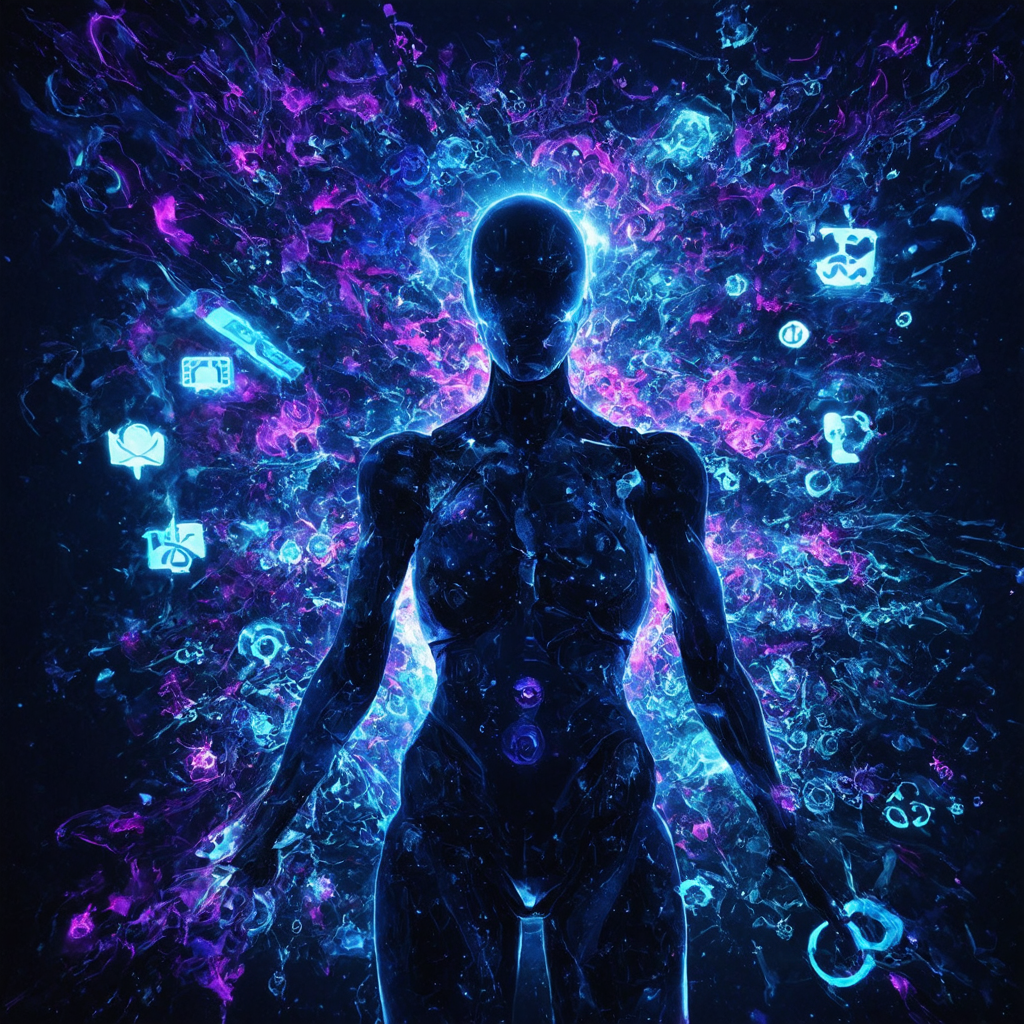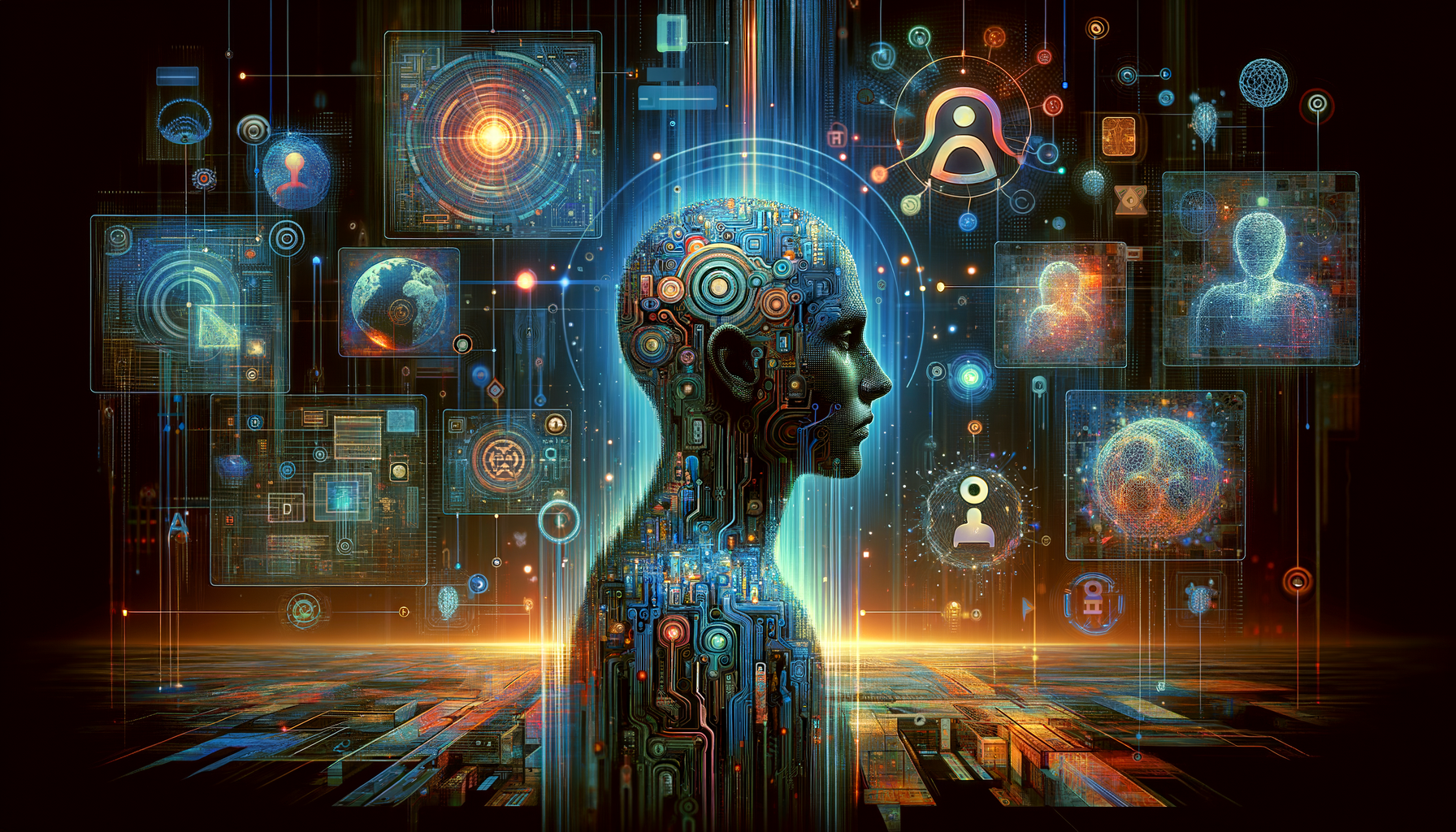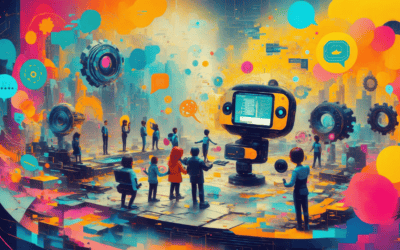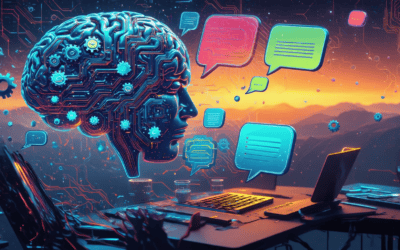In today’s digital landscape, businesses are constantly seeking innovative ways to enhance customer engagement and streamline operations. Enter the world of visual chatbot builders, a game-changing solution that empowers companies to create intelligent, interactive AI assistants without extensive coding knowledge. These powerful tools combine user-friendly interfaces with advanced artificial intelligence capabilities, making it easier than ever to design, deploy, and manage chatbots tailored to your specific needs. Whether you’re looking to automate customer support, boost sales, or simply provide a more personalized user experience, visual chatbot builders offer a versatile platform for bringing your AI assistant vision to life. In this comprehensive guide, we’ll explore the ins and outs of visual chatbot creation, compare top builder platforms, and uncover the best practices for crafting a chatbot that truly resonates with your audience.
Understanding Visual Chatbot Builders
In today’s digital landscape, visual chatbot builders have emerged as powerful tools for businesses seeking to enhance their customer engagement strategies. These innovative platforms allow companies to create interactive, AI-driven chatbots without extensive coding knowledge, revolutionizing the way we approach customer service and marketing automation.
What is a visual chatbot?
A visual chatbot is an AI-powered conversational interface that uses graphical elements and intuitive design to facilitate interactions between users and automated systems. Unlike traditional text-based chatbots, visual chatbots incorporate images, buttons, carousels, and other visual components to create a more engaging and user-friendly experience. These chatbots can be customized to match a brand’s aesthetic and deployed across various platforms, including websites, social media, and messaging apps.
At Messenger Bot, we’ve harnessed the power of visual chatbots to provide businesses with a sophisticated automation platform that enhances digital communication. Our AI-driven technology allows for real-time, automated responses across multiple channels, including Facebook, Instagram, and websites, ensuring seamless interaction with users.
Key features of visual chatbot builders
Visual chatbot builders come equipped with a range of features designed to simplify the creation process and maximize effectiveness. Some essential features include:
- Drag-and-drop interfaces: These allow users to construct conversation flows without coding, making chatbot creation accessible to non-technical team members.
- Pre-built templates: Many platforms offer customizable templates for common use cases, speeding up the development process.
- Visual flow editors: These tools enable users to map out complex conversation paths and decision trees visually.
- Integration capabilities: The ability to connect with CRM systems, databases, and other business tools is crucial for creating powerful, data-driven chatbots.
- Analytics and reporting: Built-in analytics help businesses track chatbot performance and user engagement metrics.
Our Messenger Bot platform incorporates these key features and more, including advanced workflow automation and multilingual support. This allows businesses to create dynamic, tailored interactions that improve user engagement and satisfaction across global markets.
Visual chatbot builders like ours are transforming the landscape of customer interaction. By leveraging AI and intuitive design, these tools empower businesses to create sophisticated chatbots that can handle complex queries, generate leads, and provide personalized experiences at scale. As we continue to innovate in this space, the potential for visual chatbots to revolutionize customer service and marketing automation is boundless.

Getting Started with Visual Chatbot Creation
As businesses increasingly recognize the value of visual chatbots in enhancing customer engagement, the demand for effective visual chatbot builders has surged. These innovative tools empower companies to create interactive, visually appealing chatbots without extensive coding knowledge. Let’s explore how to embark on your visual chatbot creation journey and the essential tools you’ll need along the way.
How do you make a virtual chatbot?
Creating a virtual chatbot has become more accessible than ever, thanks to advanced visual chatbot builder platforms. Here’s a step-by-step guide to get you started:
- Define your chatbot’s purpose: Determine the specific goals and functions your chatbot will serve.
- Choose a visual chatbot builder: Select a platform that aligns with your needs and technical expertise. Our Messenger Bot offers an intuitive interface for creating sophisticated AI-powered chatbots.
- Design your chatbot’s flow: Map out the conversation paths and decision trees using the visual interface.
- Craft engaging messages: Write clear, concise responses that reflect your brand’s voice.
- Integrate AI capabilities: Leverage natural language processing to enhance your chatbot’s understanding and responses.
- Test thoroughly: Simulate various user interactions to ensure your chatbot functions as intended.
- Deploy and monitor: Launch your chatbot and continuously analyze its performance for improvements.
Remember, the key to a successful visual chatbot lies in its ability to provide value to users while maintaining a seamless, visually appealing interaction.
Essential tools for chatbot development
To create effective visual chatbots, you’ll need a suite of tools that facilitate design, development, and deployment. Here are some essential tools to consider:
- Visual chatbot builders: Platforms like Messenger Bot offer drag-and-drop interfaces for creating chatbot flows without coding.
- AI and NLP engines: Integrate natural language processing capabilities to enhance your chatbot’s understanding and response generation.
- Design tools: Use graphic design software to create visually appealing elements for your chatbot interface.
- Analytics platforms: Implement tools to track user interactions and chatbot performance.
- Integration APIs: Connect your chatbot to various platforms and services to extend its functionality.
- Testing frameworks: Utilize specialized testing tools to ensure your chatbot performs correctly across different scenarios.
While there are numerous chatbot solutions available, it’s crucial to choose tools that align with your specific needs and technical capabilities. For instance, Brain Pod AI offers advanced AI writing capabilities that can be integrated into your chatbot development process, enhancing the quality of responses and content generation.
By leveraging these essential tools and following best practices in visual chatbot creation, you can develop engaging, effective chatbots that elevate your customer interactions and streamline your business processes. Remember to continually refine and update your chatbot based on user feedback and performance metrics to ensure it remains a valuable asset to your digital strategy.
III. Comparing Top Visual Chatbot Builder Platforms
When it comes to creating a visual chatbot, choosing the right platform is crucial for success. As the demand for chatbots continues to grow, numerous visual chatbot builders have emerged, each offering unique features and capabilities. Let’s explore some of the top contenders in the market and evaluate their strengths to help you make an informed decision.
A. Which chatbot builder is best?
Determining the best chatbot builder depends on your specific needs, budget, and technical expertise. Here are some top-rated visual chatbot builders worth considering:
1. Messenger Bot: Our platform offers a user-friendly interface combined with powerful AI capabilities, making it an excellent choice for businesses of all sizes. With features like automated responses, workflow automation, and multilingual support, Messenger Bot stands out as a versatile solution for creating engaging visual chatbots.
2. Dialogflow: Owned by Google, Dialogflow is known for its natural language processing capabilities and seamless integration with Google services. It’s particularly well-suited for developers looking to create sophisticated chatbots with advanced AI features.
3. MobileMonkey: This platform specializes in creating chatbots for Facebook Messenger, Instagram, and SMS. It offers a drag-and-drop interface and pre-built templates, making it accessible for users with limited technical skills.
4. ManyChat: Another popular choice for Facebook Messenger bots, ManyChat provides a visual flow builder and a range of marketing-focused features. It’s particularly favored by small businesses and marketers.
5. Botpress: An open-source platform that offers flexibility and customization options. It’s ideal for developers who want more control over their chatbot’s functionality and are comfortable with coding.
When choosing a chatbot builder, consider factors such as ease of use, integration capabilities, scalability, and customer support. It’s also worth exploring each platform’s tutorials and documentation to gauge the learning curve and available resources.
B. Evaluating free vs. paid options
Many visual chatbot builders offer both free and paid plans, each with its own set of features and limitations. Here’s what to consider when evaluating these options:
Free options:
– Ideal for beginners or small businesses testing the waters
– Often include basic features and limited bot interactions
– May have restrictions on the number of users or messages
– Typically offer limited customization and integration options
– Can be sufficient for simple chatbots or proof-of-concept projects
Paid options:
– Provide access to advanced features like AI-powered responses and analytics
– Offer higher message and user limits
– Include more extensive customization and branding options
– Provide better integration with third-party tools and platforms
– Often come with dedicated customer support
For those just starting out, a free trial can be an excellent way to test a platform’s capabilities before committing to a paid plan. Many providers, including Messenger Bot, offer trial periods that allow you to explore premium features without immediate financial commitment.
When considering paid options, evaluate the pricing structure carefully. Some platforms charge based on the number of users or messages, while others offer tiered plans with different feature sets. Consider your long-term needs and potential growth to ensure the platform can scale with your business.
It’s also worth noting that while free options can be tempting, they often come with limitations that may hinder your chatbot’s effectiveness as your needs grow. Investing in a paid plan can provide access to more robust features, better security, and ongoing support, which can be crucial for creating a professional and reliable visual chatbot.
Ultimately, the choice between free and paid options depends on your specific requirements, budget, and long-term goals. By carefully evaluating the features, limitations, and potential return on investment of each option, you can select the visual chatbot builder that best aligns with your needs and helps you create engaging, effective chatbots for your audience.
IV. Exploring Visual Chatbot Builder Software
As we delve deeper into the world of visual chatbot builders, it’s crucial to explore the software options available. These tools are designed to simplify the process of creating intelligent, responsive chatbots without the need for extensive coding knowledge. Let’s examine some popular choices and how they incorporate AI capabilities to enhance chatbot functionality.
A. Popular visual chatbot builder software options
The market for visual chatbot builders has expanded rapidly, offering a variety of options to suit different needs and skill levels. Some standout platforms include:
- Messenger Bot: Our AI-powered platform offers an intuitive visual interface for creating sophisticated chatbots. With features like automated responses and workflow automation, we make it easy to build chatbots that can engage users across multiple channels.
- Dialogflow: Google’s chatbot builder is known for its natural language processing capabilities and integration with Google Cloud services.
- MobileMonkey: This platform specializes in creating chatbots for Facebook Messenger, Instagram, and SMS, with a focus on marketing and lead generation.
- Chatfuel: Popular among marketers, Chatfuel offers a no-code solution for building chatbots primarily for Facebook Messenger.
Each of these chatbot builders offers unique features, but they all share the common goal of making chatbot creation accessible to users with varying levels of technical expertise.
B. Integrating AI capabilities in chatbot creation
The integration of AI in visual chatbot builders has revolutionized the way we create and deploy chatbots. Advanced AI capabilities enable chatbots to understand context, learn from interactions, and provide more human-like responses. Here’s how AI is being integrated into chatbot creation:
- Natural Language Processing (NLP): AI-powered NLP allows chatbots to understand and interpret human language more accurately, enabling more natural conversations.
- Machine Learning: Chatbots can learn from past interactions to improve their responses over time, becoming more efficient and accurate.
- Sentiment Analysis: AI can analyze user sentiment during conversations, allowing chatbots to adjust their tone and responses accordingly.
- Personalization: AI enables chatbots to personalize interactions based on user data and behavior, creating more engaging experiences.
At Messenger Bot, we’ve integrated advanced AI capabilities to ensure our visual chatbot builder creates intelligent, responsive bots. Our platform leverages these AI technologies to help businesses build chatbots that can handle complex queries, provide personalized responses, and continuously improve their performance.
By utilizing AI in chatbot creation, businesses can develop more sophisticated virtual assistants capable of handling a wide range of tasks, from customer support to lead generation. This not only improves efficiency but also enhances the overall user experience, making interactions with chatbots more natural and productive.
As the field of AI continues to advance, we can expect even more innovative features to be incorporated into visual chatbot builders, further simplifying the process of creating highly intelligent and responsive chatbots.

V. Leveraging Online Visual Chatbot Builders
As we delve into the world of online visual chatbot builders, it’s clear that these platforms are revolutionizing the way businesses interact with their customers. At Messenger Bot, we’ve seen firsthand how cloud-based solutions are making it easier than ever to create sophisticated chatbots without extensive coding knowledge.
A. Visual chatbot builder online platforms
The rise of visual chatbot builder online platforms has democratized chatbot creation, allowing businesses of all sizes to implement AI-driven customer service solutions. These platforms offer intuitive drag-and-drop interfaces that simplify the process of designing conversational flows and integrating various functionalities.
One standout feature of many online visual chatbot builders is their ability to integrate with popular messaging platforms. For instance, our Messenger Bot features include seamless integration with Facebook Messenger, enabling businesses to reach customers where they already spend their time.
When choosing a visual chatbot builder, it’s essential to consider factors such as ease of use, customization options, and integration capabilities. Platforms like Brain Pod AI offer advanced AI writing capabilities that can enhance your chatbot’s conversational abilities, making it an excellent choice for businesses looking to create more sophisticated bots.
B. Advantages of cloud-based chatbot development
Cloud-based chatbot development offers numerous advantages over traditional on-premise solutions. Here are some key benefits:
1. Scalability: Cloud-based platforms can easily handle increases in user traffic without requiring significant infrastructure investments.
2. Accessibility: Developers can work on chatbots from anywhere, facilitating remote collaboration and continuous improvement.
3. Cost-effectiveness: With cloud solutions, businesses can avoid hefty upfront costs associated with hardware and software licenses.
4. Regular updates: Cloud-based platforms often provide automatic updates, ensuring that your chatbot always has access to the latest features and security patches.
5. Integration capabilities: Many cloud-based chatbot builders offer pre-built integrations with popular business tools, streamlining workflow automation.
At Messenger Bot, we’ve designed our pricing plans to cater to businesses of all sizes, ensuring that everyone can benefit from cloud-based chatbot development. Our platform combines the power of visual chatbot creation with the flexibility of cloud hosting, allowing you to focus on crafting engaging conversations rather than managing infrastructure.
To get started with cloud-based chatbot development, consider taking advantage of our free trial offer. This will give you hands-on experience with our visual chatbot builder and help you understand how cloud-based solutions can benefit your business.
In conclusion, leveraging online visual chatbot builders and embracing cloud-based development can significantly enhance your ability to create effective, scalable chatbots. As the demand for AI-powered customer service continues to grow, these tools will become increasingly vital for businesses looking to stay competitive in the digital landscape.
VI. Free and Open-Source Solutions
As the demand for visual chatbot builders continues to grow, many businesses and developers are seeking cost-effective solutions. Free and open-source options have become increasingly popular, offering a range of features and customization possibilities. Let’s explore the availability of free chatbot builders and some open-source alternatives.
A. Is chatbot Builder free?
While many visual chatbot builders offer paid plans with advanced features, there are indeed free options available in the market. These free chatbot creators often provide basic functionalities that can be sufficient for small businesses or those just starting with chatbot development.
Some platforms offer a freemium model, allowing users to create and deploy simple chatbots without cost, while reserving more advanced features for paid tiers. For instance, Messenger Bot provides a free trial offer, enabling users to explore its capabilities before committing to a paid plan.
It’s important to note that while free chatbot builders can be a great starting point, they may have limitations in terms of customization, integration options, or the number of chatbot interactions allowed. As your needs grow, you might find it necessary to upgrade to a paid plan or explore more robust solutions.
B. Exploring open-source chatbot builder alternatives
For those seeking more flexibility and control over their chatbot development, open-source alternatives can be an excellent choice. These solutions allow developers to access and modify the source code, enabling extensive customization and integration possibilities.
Some popular open-source chatbot frameworks include:
1. Rasa: A powerful machine learning-based framework for building contextual AI assistants and chatbots.
2. Botpress: An open-source platform that combines natural language understanding with visual flow editing for creating sophisticated chatbots.
3. Botkit: A developer tool for building chat bots, apps, and custom integrations for major messaging platforms.
These open-source options provide a solid foundation for building AI-powered chatbots with advanced capabilities. However, they often require more technical expertise compared to visual chatbot builders.
When considering open-source solutions, it’s crucial to evaluate factors such as community support, documentation quality, and compatibility with your existing tech stack. While these platforms offer great flexibility, they may require more time and resources for development and maintenance.
For businesses looking for a balance between customization and ease of use, Messenger Bot’s free trial can be an excellent starting point. It offers the benefits of a visual chatbot builder while providing the option to scale up as your needs grow.
In conclusion, whether you opt for a free visual chatbot builder or an open-source alternative depends on your specific requirements, technical expertise, and long-term goals. Both options have their merits, and careful consideration of your needs will help you make the right choice for your chatbot development journey.
VII. Optimizing Your Visual Chatbot for Success
When it comes to creating a successful visual chatbot, optimization is key. By focusing on design, user experience, and performance metrics, you can ensure your chatbot not only meets but exceeds user expectations. Let’s explore some best practices and measurement techniques to help you create a chatbot that truly stands out.
A. Best practices for chatbot design and user experience
Designing an effective visual chatbot requires careful consideration of both aesthetics and functionality. Here are some key best practices to keep in mind:
1. Keep it simple: A clean, intuitive interface is crucial. Avoid cluttering the chat window with unnecessary elements that might confuse users.
2. Use visual cues: Incorporate buttons, carousels, and quick replies to guide users through conversations more efficiently.
3. Personalize the experience: Utilize user data to tailor responses and recommendations, making interactions more relevant and engaging.
4. Implement natural language processing: Ensure your chatbot can understand and respond to various phrasings of the same question.
5. Provide clear options: Always give users a way to easily access human support or return to the main menu if they get stuck.
6. Maintain brand consistency: Align your chatbot’s visual elements and tone of voice with your overall brand identity.
7. Optimize for mobile: With the increasing use of mobile devices, ensure your visual chatbot is responsive and functions smoothly on smaller screens.
By implementing these practices, you can create a more engaging and user-friendly chatbot experience. Remember, the goal is to make interactions as smooth and intuitive as possible for your users.
B. Measuring and improving chatbot performance
To ensure your visual chatbot is meeting its objectives and continuously improving, it’s essential to track and analyze its performance. Here are key metrics and strategies to consider:
1. Conversation completion rate: Monitor how many users successfully complete their intended tasks or reach a satisfactory resolution.
2. User satisfaction: Implement post-conversation surveys to gather direct feedback from users about their experience.
3. Fallback rate: Track how often your chatbot fails to understand user queries and reverts to default responses.
4. Response time: Measure how quickly your chatbot responds to user inputs, aiming for near-instantaneous replies.
5. Engagement metrics: Analyze the number of messages exchanged per conversation and the average conversation duration.
6. Conversion rate: If your chatbot is designed to drive sales or lead generation, track how many conversations result in desired actions.
7. Retention rate: Monitor how many users return to interact with your chatbot multiple times.
To improve performance based on these metrics:
1. Regularly review conversation logs to identify common issues or misunderstandings.
2. Update your chatbot’s knowledge base with new information and frequently asked questions.
3. A/B test different conversation flows and visual elements to optimize user experience.
4. Implement machine learning algorithms to improve your chatbot’s natural language understanding over time.
5. Continuously train your AI chatbot with new data to enhance its responses and capabilities.
By consistently measuring and refining your visual chatbot’s performance, you can create a more effective tool that truly meets your users’ needs. Remember, chatbot optimization is an ongoing process, and staying responsive to user feedback and changing trends is crucial for long-term success.
Tools like Brain Pod AI’s Multilingual AI Chat Assistant can be invaluable in this process, offering advanced features to help you create, optimize, and maintain high-performing chatbots across multiple languages and platforms.




